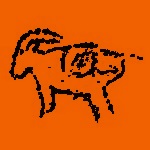 This paper describes a modest petroglyph site just south of the Anti-Atlas of southern Morocco. It is found on a rocky hill, called Jorf Naga, where at least three other rock art sites have been recorded. All four sites play an important role in the rock art traditions of the most important rock art complex of Imaoun and the drainage of Wadi Akka, which – in ancient times – was definitely used as an important north-south migratory route through the Anti-Atlas to the contact zone with the Sahara.
This paper describes a modest petroglyph site just south of the Anti-Atlas of southern Morocco. It is found on a rocky hill, called Jorf Naga, where at least three other rock art sites have been recorded. All four sites play an important role in the rock art traditions of the most important rock art complex of Imaoun and the drainage of Wadi Akka, which – in ancient times – was definitely used as an important north-south migratory route through the Anti-Atlas to the contact zone with the Sahara.
By Maarten van Hoek
*
*
Petroglyphs of Imaoun-3A
Southern Morocco
Maarten van Hoek
Cover Photo: View from Imaoun-3A looking west across Wadi Akka. Note the lonesome camelid on the valley floor (see also my video). Photograph © by Maarten van Hoek.
Click on any illustration to see an enlargement.
*
Introduction
Just north of the village of Akka in southern Morocco is Foum Akka; a narrow natural passage through the high and very long and narrow mountain ridge of Jebel Bani (Figures 1 and 2). Through the foum (the gap) runs the mainly dry stream of Oued (Wadi) Akka, from its origin in the Anti-Atlas north of Jebel Bani to the River Draa south of Jebel Bani. Most likely because this wadi was once an important north-south route, its course is lined with many important rock art sites, like Oum el Aleg, Adrar Metgourine and adjacent Imgrad Tayaline, and – much further north – the Imaoun Rock Art Complex.
Figure 1. The location of the Imaoun Rock Art Complex. Map © by Maarten van Hoek, based on the map © by OpenStreetMap – Contributors.
Figure 2. The location of the Imaoun Rock Art Complex, showing only Imaoun-1 and 3. There are many more rock art sites in the area shown here. Map © by Maarten van Hoek, based on the map © by OpenStreetMap – Contributors.
*
The Imaoun Rock Art Complex
Best known of the Imaoun Rock Art Complex is the major site: Imaoun-1, a long, yet low, flat-topped rocky ridge overlooking the vast “feija” (plain) of Imaoun in all directions. Its rock art has partially been described by several rock art researchers (for instance Simoneau 1977: Planches 66 to 70; Searight 1999, 2001; Gauthier and Gauthier 2015; Van Hoek 2019), but a complete scientific inventory was never compiled (see also Note 1 at the end of this study).
Less known – and fortunately less visited – is the rock art site of Imaoun-3 (for location see Figures 1, 2, 3 and 4), part of which is the subject of this paper. As far as I know, only the paper by Garcin and Garcin (2004) offered information about Imaoun-3A and 3B, including several photos, some showing petroglyphs (2004: Figs 1 to 11) at a site that we did not visit during our visit (Imaoun-3D). Also an internet page describes the rock art at Imaoun-3, but only deals with Imaoun-3B. It seems as if a “minor” part (Imaoun-3A) and also Imaoun-3D have been ignored: “A few engravings of little interest are visible before arriving at the major site …” (freely translated by me from French; based on Gandini 2008-2019). This study hopes to fill a small void in the recording of the rock art in Morocco, by presenting a short overview and photographs of the allegedly “less interesting” petroglyphs that my wife and I recorded in 2019 at Imaoun-3A (the only part of Imaoun-3 that we visited).
*
Imaoun-3
The rock art site of Imaoun-3 is found about 1500 m west of Imaoun-1 (Figure 3). Both sites are clearly intervisible (see Figures 12 and 14). Imaoun-3 occupies a low hill (called Jorf Naga by Alain Rodrigue [pers. comm. 2024]), rather than a low, long platform bordered by rocky cliffs like at Imaoun-1. In fact there are four spots with rock art at Imaoun-3; all overlooking Wadi Akka. I have labelled those four sites Imaoun-3A, B, C and D (Figure 4). Imaoun-3A occupies a rocky area at the north end of the hill and is located at a lower level (at about 735 m asl). This study mainly offers detailed information about Imaoun-3A.
Figure 3. The location of Imaoun-3. Map © by Maarten van Hoek, based on Google Earth.
Figure 4. The locations of the rock art sites of Imaoun-3A to D (all approximated). Map © by Maarten van Hoek, based on Google Earth.
Roughly 340 m further to the SW and uphill is Imaoun-3B, occupying a much fractured, flat, yet sloping outcrop area of about 70 m in length and 2 to 4 meters in width (at 790 m; located roughly between the two circles in Figure 4). It forms the edge of the steep escarpment to the NW, and thus overlooks Wadi Akka as well. It is impossible to see Imaoun-3B from Imaoun-3A, and – although not checked by us – it is also impossible to see Imaoun-1 from Imaoun-3B. At Imaoun-3B are numerous, often deeply patinated petroglyphs (Garcin and Garcin 2004), mainly abstracts, like spirals, random lines, ovals and [concentric] circles and some biomorphic figures (like [possible] antelopes, goats, horse-and-riders, sandals and/or human footprints) and at least one petroglyph of a chariot (Gauthier and Gauthier 2015: Fig. 9). Especially some biomorphs are much less patinated. The possibly Libyco-Berber Style images at Imaoun-3B (Jorf Naga) seem not to have been mentioned in the thesis by Alessandra Bravin 2014.
About 40 m SE of Imaoun-3B is Imaoun 3C, a site surveyed by Yves and Christine Gauthier and marked on their map of a study about rock art images of chariots in Morocco (Gauthier and Gauthier 2015: Fig. 1; location approximated in my Figures 3 and 4). It is possible that there are views of Imaoun-1 and 2 (see Figure 15). Based on their illustrations I only know of the three petroglyphs depicting chariots that have been described by Gauthier and Gauthier (2015: Figs 10 to 13). Of course there may be more (panels with) petroglyphs at Imaoun-3C, as well as at other spots at Jorf Naga.
Besides Imaoun-3A and 3B, Annie and Gérard Garcin also recorded the important rock art site of Imaoun-3D in 2001/2003, and in 2004 they published a photographic record illustrating some of the panels with petroglyphs at site 3D. Imaoun-3D is located at the foot of a high, almost vertical cliff (invisible from Imaoun-1) comprising many outcrops (Figure 5).
At Imaoun-3D a band of suitable rock panels at the foot of the cliff has been adorned with some abstract images and several zoomorphic petroglyphs. One of the most interesting abstract motifs of Imaoun-3D is a large example of the so-called Venus-Cross Symbol (Garcin and Garcin 2004: Fig. 5); in fact a simple cross surrounded by one or more concentric crosses. It is almost similar to some large examples at Imaoun-1 (Figure 6), confirming a definite link between those two sites. The other petroglyphs mainly depict quadrupeds; predominantly bovines that are looking to the right, as if welcoming travellers arriving from the NW via Wadi Akka.
Figure 5. The rock art site of Imaoun-3 on the hill of Jorf Naga (looking south across Wadi Akka). All locations are only approximated. Photograph © by Maarten van Hoek.
Figure 6. Two petroglyphs of the so-called Venus Cross at Imaoun-1. Photographs © by Maarten van Hoek
*
Imaoun-3A
The rock art site of Imaoun-3A roughly occupies a narrow area of an estimated ten meters in length and only a few meters in width. The rock panels with petroglyphs are randomly distributed across that area and are not found very near the escarpment (like at Imaoun-3B) as you can see in Figure 10. The site also overlooks Wadi Akka (to the NW and to the east across the vast “feija” of Imaoun). Therefore there are excellent views of Imaoun-1 to the east (see Figure 14) and Imaoun 2 to the ENE (see my video). Altogether we recorded nine boulders with petroglyphs (there may be more, of course) that will be briefly discussed in random order, since – lacking time – no site plan was made. Scales and bearings are not available.
*
PANEL I-3A-001: Two crudely pecked quadrupeds with some simple interior decoration (un-pecked areas). Both are looking to the left (Figure 7). Some crudely pecked wandering lines, some attached to the backs of the animals (some possibly continuing on the other side of the boulder). Areas of rough pecking or hacking.
Figure 7. Panel I-3A-001 at Imaoun-3A. Photograph © by Elles van Hoek.
*
PANEL I-3A-002: Two fully pecked petroglyphs of bovines, both looking to the right (Figure 8). It seems as if the smaller bovine has had its horn added at a later stage. This petroglyph was also recorded in 2003 by Garcin and Garcin (2004: Fig. 13).
Figure 8. Panel I-3A-002 at Imaoun-3A. Photograph © by Maarten van Hoek.
*
PANEL I-3A-003: One petroglyph of an almost fully pecked bovine that looks to the right (Figure 9).
Figure 9. Panel I-3A-003 at Imaoun-3A. Photograph © by Maarten van Hoek.
*
PANEL I-3A-004: One petroglyph of an almost fully pecked bovine that looks to the right on a SSE facing panel (Figure 10).
Figure 10. Panel I-3A-004 at Imaoun-3A. Photograph © by Maarten van Hoek.
*
PANEL I-3A-005: One petroglyph of an almost fully pecked bovine (Figure 11). Notice the tufted tail-end. In front of the right-looking animal are some possible pecked grooves forming no recognisable pattern. Hovering over the bovid may be an area of anthropic (?) pecking, which just possibly might depict an unfinished bovid.
Figure 11. Panel I-3A-005 at Imaoun-3A. Photograph © by Maarten van Hoek.
*
PANEL I-3A-006: Boulder with two petroglyphs of bovines, both looking to the right (Figure 12), the example with the long tail (having a tufted tail-end) is almost fully pecked and has long irregularly curving horns above which are some faint pecked lines. To the left is the second bovine (Figure 12: detail).
Figure 12. Panel I-3A-006 at Imaoun-3A. Photograph © by Maarten van Hoek.
*
PANEL I-3A-007: Unidentified pattern of thin, roughly pecked, curved lines (possibly depicting an outlined ostrich?) (Figure 13).
Figure 13. Panel I-3A-007 at Imaoun-3A. Photograph © by Maarten van Hoek.
*
PANEL I-3A-008: West facing panel of a rock slab (at the east end of Imaoun-3A) with either a row of U-shaped petroglyphs or perhaps a serpentine groove (Figure 14). Notice the dust-devil that races to the north almost across Imaoun-1 (the thin, dark-brown line of the outcrop ridge in the left-centre of the picture).
Figure 14. Panel I-3A-008 at Imaoun-3A looking east. Notice the dust-devil at the far south end of Imaoun-1. Photograph © by Maarten van Hoek.
*
PANEL I-3A-009: A roughly anthropomorphic-looking (male?) figure (showing two polished legs, a body, head and arms) amidst areas of small, natural pits (or anthropic pecking?) (Figure 15). It looks as if the figure has been polished. It may therefore possibly belong to the Tazina Style (which seems to be lacking at Imaoun-3). This petroglyph was also recorded in 2003 by Garcin and Garcin (2004: Fig. 31).
Figure 15. Panel I-3A-009 at Imaoun-3A. Photograph © by Maarten van Hoek.
*
Conclusions
Indeed, I “agree” with Gandini that Imaoun-3A is “only” a rock art site of “little interest”, but in my opinion this is only relatively speaking. The fact that – so far – “only nine” decorated panels have been reported by us at Imaoun-3A, with a grand total of “only fourteen” petroglyphs, does not mean that the site has little or no importance. A “minor” site like this must always be viewed in the context of its setting, because it is definitely related to the other rock art sites at Imaoun-3 and of course to Imaoun-1 (and 2, and all others in the drainage of Wadi Akka). That relationship seems also to be confirmed by the fact that from Imaoun-1 the rock art site of Imaoum-3A is visible (Figures 16 and 17) and vice-versa, of course (see Figure 14).
Figure 16. View from a large decorated boulder at Imaoun-1, looking west across a part of the vast “feija” of Imaoun and Wadi Akka towards the rock art site of Imaoun-3A on the hill called Jorf Naga by Alain Rodrigue. Photograph © by Maarten van Hoek.
Figure 17. View from a large decorated boulder at Imaoun-1, looking west across a part of the vast “feija” of Imaoun and Wadi Akka. Photograph © by Maarten van Hoek.
*
I am convinced that Imaoun-3A is part of an extensive ceremonial, migratory landscape that was continuously ritually charged by adding important images onto the rock surfaces. The fact that Imaoun-3A mainly houses images of quadrupeds (nine in total, of which eight definitely are bovines [one example on Boulder I-3A-001 is too much worn to be certain]), may indicate that those bovines all belong to one (long) period in time. At Imaoun-3A there are no Libyco-Berber images (like at Imaoun-3B and Imaoun-1) and no petroglyphs of goats (like at Imaoun-3B). There is only one boulder with a geometric design (see Figure 14) and a few wandering lines (see Figure 7), against possibly a few hundred of such abstracts at Imaoun-3B. I now argue that the difference between the graphic content of Imaoun-3A and 3B is of importance. Another difference is that Imaoun-3A overlooks the ancient route through Wadi Akka in both directions, while Imaoun-3B (and 3D) only overlooks the tract coming from the NW (see Figure 3).
Unfortunately, it could not be checked whether the rock art site of Imaoun-3C is visible from Imaoun-1 and vice versa (Figure 17), neither is anything known – to me – about the complete graphical content of that site (only the limited information published by Gauthier and Gauthier [2015] is known to me). Therefore a full survey of all Imaoun-3 sites mentioned in this study is highly desirable. Finally, it must be accepted that also “minor” sites with little or no variation in graphic design (in contrast for example with the “minor” rock art site of Tizounine that shows much more variation in imagery on only 15 panels [Van Hoek 2024: Fig. 1]) are important and deserve a full survey.
*
Note 1
It is remarkable to notice that the very extensive, yet most puzzlingly detailed survey of the rock art in the area around Foum Akka by Renate Heckendorf (2008) does not seem to include any information about the – in my opinion – most important and truly exceptional rock art site in this area: Imaoun-1. After a long and tiresome search I finally found out that Imaoun-1 has confusingly been listed by her as TM2/04: Imaoun Assif Touna (or just Assif Touna [2008: 147]), without clarifying that her TM2/04 is actually known as Imaoun-1. The red arrow in Figure 18 may indicate the location (and direction?) of Assif Touna. Heckendorf also refers to André Simoneau (1977) whose catalogue number of Imaoun Assif Touna is 15.0109 (yet, his photos demonstrably depict images from Imaoun-1). Simoneau also called this site Tleta de Tagmoute.
Much later Susan Searight included Imaoun Assif Touna as S-32 in her thesis (2001: 303), repeating Simoneau’s (1977) catalogue number 15.0109 as well. However, in her extensive thesis about the rock art of Morocco Searight (2001) briefly described three then known sites of the Imaoun Complex. The main site is called Imaoun South by her (referred to in this study as Imaoun-1), while (only 110 m) to the north – across a dry river bed – is Imaoun North (Imaoun-2) and about 2000 m to the west is Imaoun West (Imaoun-3 or Jorf Naga). Surprisingly Heckendorf (2008) did not refer to the most informative paper by Searight (1999) describing and lavishly illustrating Imaoun-1.
In itself it is not a problem using the name of Imaoun Assif Touna (which was introduced by Simoneau in 1977), to indicate Imaoun-1, as long as it will be made clear which site it concerns. It is thus most surprising to see that site TM2/04 – called Imaoun Assif Touna by Heckendorf (which thus in fact refers to Imaoun-1) – has completely incorrectly been marked on her map of the Imaoun area (2008: Abb. 50. Karte 3). On her Abb. 50. Karte 3, the site of TM/04 (Imaoun Assif Touna) is located 1100 to 2000 m NNE of the factual location of rock art site of Imaoun-1 (Figure 18). More unexpected is the fact that the unique site of Imaoun-1 and the rock art sites of Imaoun-2 and Imaoun 3 (reported by Garcin and Garcin in 2004) have not even been marked on her Abb. 50. Karte 3 (2008).
Concluding, three rock art sites (the yellow dots in Figure 18) are missing on the map by Heckendorf and her TM/04 is incorrectly indicated. Those three missing sites have not been described, mentioned or illustrated by her, while it is certain that Imaoun-1 houses one of the most important rock art sites in (southern) Morocco. Any researcher recording the rock art in the Wadi Akka drainage should – in my opinion – at least mention those important sites and include some illustrations (of at least Imaoun-1).
Figure 18. Part of the Imaoun Rock Art Complex, showing the correct locations of Imaoun-1 (roughly between the two dots), 2 (approximated) and 3 (also between two dots; see this study). The red circle (4) approximately shows the incorrect location of TM2/04: Imaoun Assif Touna (or Imaoun-1) according to Heckendorf (2008: Abb. 50. Karte 3), which is marked about 1100 m NNE of the factual location of the northern tip of Imaoun-1. Map © by Maarten van Hoek (scale about 200 m), based on Google Earth.
*
Acknowledgements
Above all I am most grateful to Alain Rodrigue for sharing with me much additional information about Imaoun-3 (pers. comm. 2024) and for reading and commenting on the draft version of this study. However, I am the only one responsible for anything or any error presented in my study. Especially many locations in this study have only been approximated by me, because I never used GPS.
I would also like to thank Paul Savonitto for arranging our excursion to the Imaoun Complex and Michel for safely driving us from Icht to Imaoun and – after a long and tiring, yet very rewarding day (the 19th of March 2019) – back to Icht. Last but not least I am of course much indebted to my wife Elles who – as usual – assisted me while surveying the three Imaoun sites in the field, as well as her support at home while preparing this article.
*
References
Bravin, A. 2014. L’art rupestre de la phase des cavaliers au Maroc: les sites de Foum Chenna (Vallée du Draa) et du Jebel Rat (Haut Atlas). Analyse iconographique, thématique et proposition de chronologie. Thèse présentée pour obtenir le grade universitaire de docteur. Université d’Aix-Marseille.
Gandini, J. 2008-2019. Vallée de l’oued Akka – L’“Ecole” d’Art graphique d’Imaoun (website).
Garcin, A. and G. Garcin. 2004. Promenade autour d’Imaoun. Cahiers de l’AARS. Vol. 9; pp. 1 – 6.
Gauthier, Y and C. Gauthier. 2015. Nouvelles figurations de chars sahariens: technicité et positionnement chronologique relativement au style de Tazina. Numero special sur les chars sahariens in: Les Cahiers de l’AARS. Vol. 18; pp. 5 – 70.
Heckendorf, R. 2008. ‘Bubalin’ und ‘Bovidien’ in Südmarokko: Kontext, Klassifikation und Chronologie der Felsbilder im mittleren Draa-Tal. Forschungen zur Archäologie Außereuropäischer Kulturen; Band 6. Bonn.
Rodrigue, A. To be published 2024. Jorf Naga (Maroc): exemple de pérennité d’un «haut lieu» rupestre. The Rock Art of Northern Africa. Third International Congres. Royal Academy for Overseas Sciences. Brussels.
Searight, S. 1999. Imaoun: un site de gravures rupestres du sud-marocain. Les Cahiers de lʼAARS. Vol. 5; pp. 15 – 26.
Searight, S. 2001. The Prehistoric Rock Art of Morocco. A Study of its extension, environment and meaning. PhD-Thesis. Bournemouth University.
Simoneau, A. 1977. Catalogue des sites rupestres du sud-marocain. Ministère d’Etat chargé des Affaires Culturelles, Rabat.
Van Hoek, M. 2019. The Cupules of the Imaoun Complex, Southern Morocco. In: TRACCE – Online Rock Art Bulletin. Italy. PDF available at ResearchGate. Video about Imaoun-1.
Van Hoek, M. 2023. The Archers of Oum el Aleg, Morocco. In: TRACCE – Online Rock Art Bulletin, Italy. PDF available at ResearchGate. Video at YouTube.
Van Hoek, M. 2024. Petroglyphs of Tizounine. Southern Morocco. In: TRACCE – Online Rock Art Bulletin, Italy. PDF available at ResearchGate.
*
Petroglyph of one goat at Imaoun-3B. Drawing © by Maarten van Hoek, based on a photograph by Martine and Gerard Tatangelo (2014). Click this drawing to see my 2020-paper about “fighting and mating” goat-petroglyphs in southern Morocco.
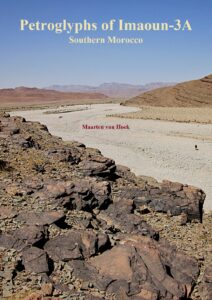
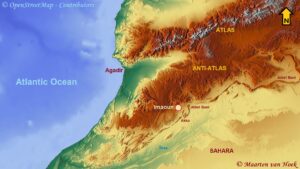
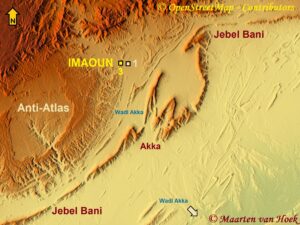
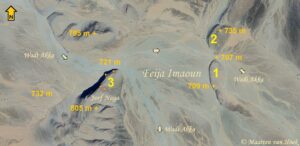
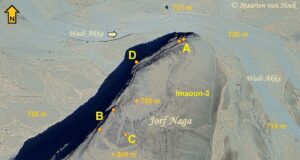
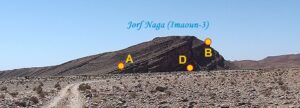

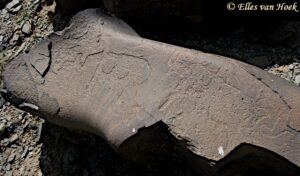
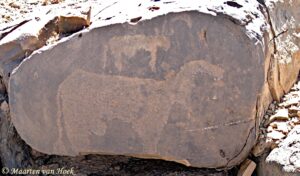
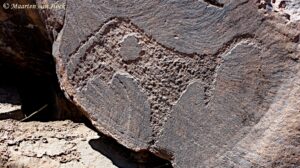
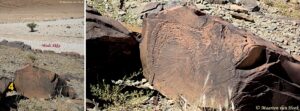
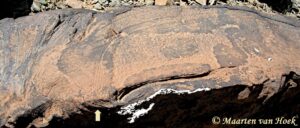
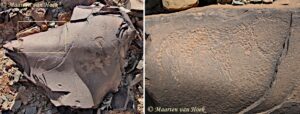
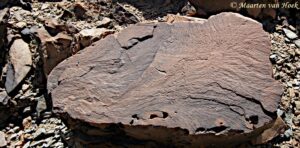
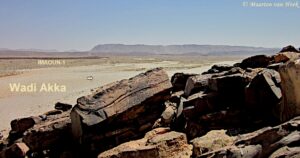
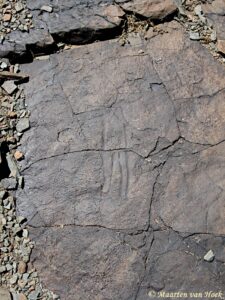

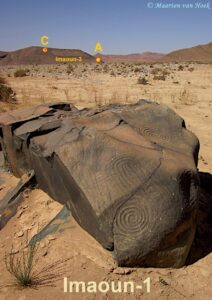
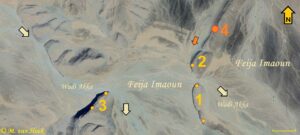















Leave a Reply